Log in or Sign up
You are using an out of date browser. It may not display this or other websites correctly. You should upgrade or use an alternative browser .

a better tiki 21
Discussion in ' Multihulls ' started by guzzis3 , May 7, 2019 .
guzzis3 Senior Member
I was wondering if anyone had had a go at designing a better tiki 21 style boat. I know about the RW acorn 21. Really nice boat. Look cheap and easy to build and from the youtube vids looks like a great performer. But I was wondering if anyone had had a go at a more Polynesian style small cabined cat ? Something with a bit of style.. From what I can see of the T21: The plans are really expensive. For what should be a simple cheap boat it looks harder than it should be. More freeboard would be nice. You aren't going to get standing headroom but 4'6" full sitting would be nice. Some asymmetry for and aft might help the hobbyhorsing, even on a V hull. The looks could be improved. Any thoughts ?
Angélique aka Angel (only by name)
You've probably seen it, Wharram now also has the Mana 24 , but only available as kits, no plans, and shipping kits around the world adds to the costs, plus you can't customise much to your ideas and preferences.
For more elbow room in a small Tiki, place the hull sides panel edge stringers on the outside of the hull side bottom panels, and the hull side top panels on the outside of the stringers. Below applied on a Tiki 26, which also has raised cabin tops. Dutch links : Tiki 26 - Castor & Pollux — Building — Preparation — Videos ( click the pics ) Below 3 pics from the preparation link : ↓ original ↓ adapted ↓ bulkhead, the red dash line is original, yellow is adapted .
No I was thinking another designer might have had a go and done some serious improvements. T21 plans are 505 POUNDS! plus vat where applicable. Acorn plans are 175 pounds after Mr Woods recent price rise. The wharrams make very little information on their boats available for free and charge you like a wounded bull for everything. Tiki 21 design is 38 years old now. I would have thought someone somewhere might have taken the general idea and improved on it. The boat needs about another 6" of freeboard at least imo... Anyway thank you for the links. The mana looks like it's had some improvements over the Tiki21, but you really have to wonder at ketch rig on a 23' catamaran. And the prices! 8k pounds!! Anyway I was just musing.
The hull length of the Mana 24 and her ketch rig is inspired on James' first Atlantic crossing in 1955 - 1956 in James' first built, a 23' 6" Wharram Tangaroa, which was a flat bottomed double canoe ... . . . . MANA’s 23’6” hull length has a special significance for James Wharram. In 1956 he made the first successful catamaran voyage across the Atlantic in his first catamaran, the ‘Tangaroa’, also 23’6” long. . . . . . . . . MANA uses the well proven Wharram Wingsail rig in a new Catrig configuration. The Wingsail rig is a modern version of a high aspect Dutch style gaff rig, sleeved round the mast for maximum aerodynamic efficiency. In this new Catrig configuration the mainsail gives the drive with a very clean leading edge. The small mizzen aids with balance, steering and tacking. Having no jib, there is no need for a very tight forestay. The standing rigging uses the latest dyneema rope, which is light and easily set up. The mizzenmast can be used as sheer pole for single-handed assembly. . . . . Click to expand...
guzzis3 said: ↑ No I was thinking another designer might have had a go and done some serious improvements. Click to expand...
![catamaran tiki 21 [IMG]](https://www.boatdesign.net/proxy.php?image=http%3A%2F%2Fwww.wallerdesign.com.au%2Fimages%2Fcs25n.jpg&hash=3cd6d7b666c60d8c8a2a61d9f29151bd)
BlueBell . . . _ _ _ . . . _ _ _
Recently, I've had opportunity to sail on a Malcolm Tenant Streaker 23. With an over height mast of 38' it went great, it has a ton of freeboard. It's an old design but what a great little cat!
There's one for sale in the Netherlands ... P . S . - a later ad has a lower asking price and shows 8 pics .... — Malcolm Tennant Streaker 23 — DIY built in 1994 — L 7.2 m × B 4,0 ( 2,5 ) m × D 1,2 ( 0,3 ) m —
rwatson Senior Member
Derek Kelsalls Plywood Cats were always a lot better than Wharram, but a similar price. Catamarans - Kelsall Catamarans - KSS 27 http://www.kelsall.com/Designs/KSS27.htm Many of his designs are now gone full Foam and Glass. They are all amatuer buildable, and a lot more comfortable than Wharram while being just as easy to construct. .
Thank you for the replies. I am aware of those other designs but they aren't what I am talking about. Boats like the coral sea 25 Ray Kendricks fish and chips and Richard Woods wizzer, eagle etc are VASTLY bigger boats. They weigh at least twice as much as a tiki 21. But the other issue is they are some of the others mentioned are conventional "modern" catamarans. Some have plumb bows, they all have flat transoms. Even the waller isn't a true V hull. I was thinking specifically about the tiki 21 and to a lesser extent the Tiki and Pahi 26. The boats are all straight stitch and glue. The 26's have extra panels to raise the freeboard, but they are all REALLY basic boats. V hulls, no boards. The tiki 21 should be a quick cheap boat to build but at just 18'6" on the water and 360 kg it's far too fussy. Acorn is the practical boat in that size. It's a beautiful design, weighs nothing, cheap plans, 1 single in each hull with adequate freeboard and headroom. It's a tiny boat but so is the tiki. What acorn lacks is the rakish looks. And with the tiki 21 being such a successful design I am quite surprised no one has had a hard look at it and devised a quicker cheaper way of making one and selling plans for same at half Wharram's price. Given the total build cost of a Tiki 21 paying 500 pounds for plans before you get started is ridiculous. And surely that cabin can be improved. As for the mana, just because JW did something 50 years ago doesn't make it a good idea then let alone now. 2 masts on a 23' boat is mad. And as I recall that origional tangaroa fell apart and they stopped and built rongo to continue sailing. I have no problem with a foam build but Derek Kelsall's plans are very expensive and his boats have modern lines. Personally I do not find all of them attractive but some are. Designing a flat panel canoe stern cat in stitch and glue or taping together some foam glass flat panels should in theory make a quick build and inherently include those "piratical lines" for a bit of fun. Build in enough freeboard, enough cabin, rake the cabin 5 degrees inboard so you can put your back against it comfortably, rather than dead vertical. Lay out the panels carefully so you can nest it with minimal waste. Make the bridgedeck maximum 8' wide to give it a tad more beam and use as much of a full ply sheet as possible. Eliminate parts and fiddly details. Push maximum beam aft a tad to combat hobbyhorsing. Mind I have not seen tiki 21 plans. I had a set of tiki 30 plans and was properly appalled at the wasted material and labour. I also had taneui foam plans and again the method was crude, but those were drawn a long time ago. Maybe the t21 is better but from what I've seen I think there is a lot of room for improvement. Anyway...
Rumars Senior Member
I don't think you can find a better 21 cat that also looks like a tiki. The tiki's looks come from the deep V, symetrical, S&G build. That's about the maximum boat you can achieve with that technique. Moving beam aft and increasing freeboard will prove difficult if not impossible. Most designers don't bother with that form anymore. It's simpler to add a chine or two and enjoy the resulting design freedom. For the builder an extra chine is just an extra cut and fillet, and the panels become more easy to handle. I think if you want a "better" tiki 21 you need a custom design. Either as a deep V or as a multichine boat with the desired look.
guzzis3 said: ↑ I was thinking specifically about the tiki 21 and to a lesser extent the Tiki and Pahi 26. The boats are all straight stitch and glue. The 26's have extra panels to raise the freeboard, but they are all REALLY basic boats. V hulls, no boards. Click to expand...
![catamaran tiki 21 [IMG]](https://www.boatdesign.net/proxy.php?image=https%3A%2F%2Fwavetrain.net%2Fwp-content%2Fuploads%2F2011%2F03%2Fpahi42aground2.jpg&hash=3042857994b1ebf96bbe38518a00ef58)
guzzis3 said: ↑ As for the mana, just because JW did something 50 years ago doesn't make it a good idea then let alone now. 2 masts on a 23' boat is mad. And as I recall that origional tangaroa fell apart and they stopped and built rongo to continue sailing. Click to expand...

redreuben redreuben
I've also looked at the idea of updating the Tiki but really it's a bit like competing with Guinness, they both totally own their segment. Working with the original plans I would go with squaring the transom and deepening the forefoot first. And then maybe more beam, more freeboard, a slightly taller rig, daggerboards, bigger fixed mast beam like Woods to define and protect the cockpit. So then its not really a Tiki anymore. Richard Woods Surfsong and Windsong are the obvious step up in this direction. When you look at this boat by Selway Fisher the Cat 254 you can see the potential for creating more curve in the sides by torturing the ply a bit, lol, or a lot ! Large Catamarans http://www.selway-fisher.com/YachtCats.htm One boat that caught my eye with an equally "salty" traditional look is the Evergreen, at 19ft it wouldn't take much to stretch it to 21. I'd lose the biplane rig though and the Tiki's Wingsail would probably suit it well. Unfortunately like most of Michael Schact's design work it never made it past vapourware. I contacted Laurie McGowan several years ago and it isn't going to be drawn up. https://proafile.com/multihull-boats/article/evergreen-a-fast-expedition-catamaran . Woods uses this hull shape on Meander, Rhea and Ondina which are much bigger boats. Just a comment on Kelsall, he had a great portfolio of designs (especially the Tonga 24 ?) but when he went to his KSS infusion builds most of them fell by the wayside and they are beyond expensive the pricing could only be described as ridiculous given that you can buy a Kendrick design for A$150 or even $100 with the monthly special. Jones boats are also worth a look although not sure of the availability since his passing. He started with Wharram type hulls and his boats did some serious offshore miles. Jones Boats Homepage http://jonesboatstuckahoe.com His books are a great read. My 2c worth.
- Advertisement:
Lets really get into the barebones spirit of small multihulls. "The fabulous and unique first Atlantic crossing , 3000 nautical miles WITH NO NAVIGATION INSTRUMENTS on a 600 pds wooden outrigger ! a lot better than hokulea, No compass, no watch, no GPS or Sextant, no log, no radio, no receiver, no chart and not one book..."
Shape of a chainplate that might spread load better?
Tacking Proa (for lack of a better term)
What’s formula for estimating catamaran speed? Speed from length better than from design?
How Junk Rigs Work, and why they are BETTER than RM
Phaedo team to attempt to better Transpac WSSRC record on Phaedo 3
Francois gabart to attempt to better solo trans atlantic, francis joyon to attempt to better crewed jules verne record onboard the former g3, mod70 oman sail attempting to better round ireland record.
Better boat
Tiki 26 Plans
- No, create an account now.
- Yes, my password is:
- Forgot your password?

Article Tag: tiki 21
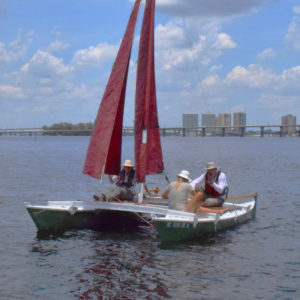
J ames Wharram’s Polynesian catamaran designs have inspired countless backyard boatbuilders with dreams of ocean voyaging to exotic tropical destinations. Starting with the simple 23’ TANGAROA, aboard which he completed the first catamaran crossing of the Atlantic in 1955–56, the cruising-sized vessels in his range of plans have an impressive safety record due to their conservative design parameters. Seaworthiness is the number-one priority in his designs.
While ocean-voyaging catamarans have been the main focus of Wharram’s design work, his plans catalog includes a few smaller boats suitable beach cruising. The Tiki 21 that was recently profiled here in Small Boats Monthly crosses the line between the two pursuits but is still a bigger boat than many people want to build or trailer. The Hitia 17 and the Hitia 14 are based on the same hull shape and design concepts as the Tiki 21 and her larger sisters, but the Hitias are open boats. They are lighter, simpler, and less expensive to build, while retaining the sailing characteristics and performance of the cruisers. While the smaller Hitia 14 is strictly a daysailer, the Hitia 17, with its dry-storage holds and kayak-style cockpits, features real camp-cruising capability for sailors who don’t mind roughing it a bit.
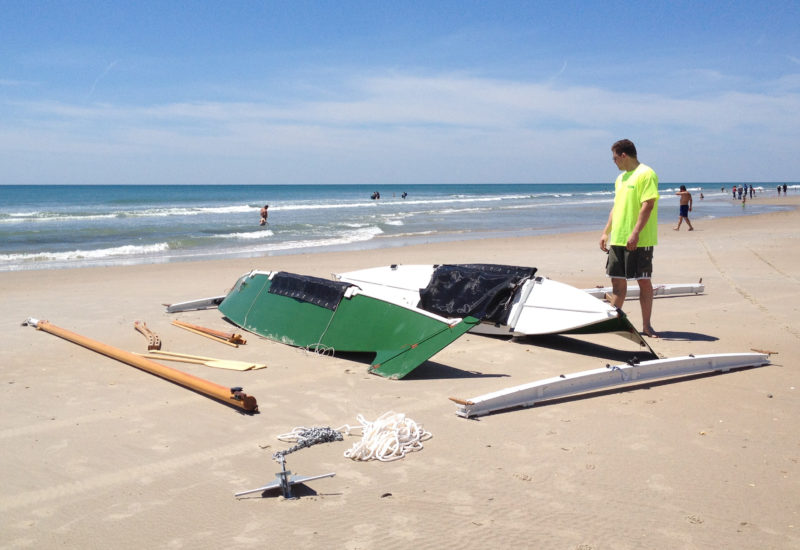
Taken apart for transport, the pieces of the Hitia 17 are light enough to be carried to the beach.
In 1997, I chose the Hitia 17 as my first sailboat build. After many years of sea kayaking and building various kayaks and canoes, I wanted to sail to the same kinds of places I could paddle craft, but I wanted to carry more stuff, and make occasional open-water crossings at faster speeds. The Hitia 17 fit the bill, and the double-canoe design appealed to my prior experiences with seaworthy small boats. It draws only 12″, is easily beachable, and could accommodate a companion or two. It offers the possibility of camping aboard if necessary—a real plus in places like Florida’s mangrove swamps where there are no campsites.
Like all Wharram catamarans, the Hitia 17 is designed for plywood construction, and the assembly method is straightforward stitch-and-glue with epoxy-fillets, taped joints, and fiberglass sheathing. The project calls for eight sheets of 1/4″ plywood and one sheet of 5/8″, as well as some straight-grained fir or spruce lumber for stringers, crossbeam parts, and mast laminates.
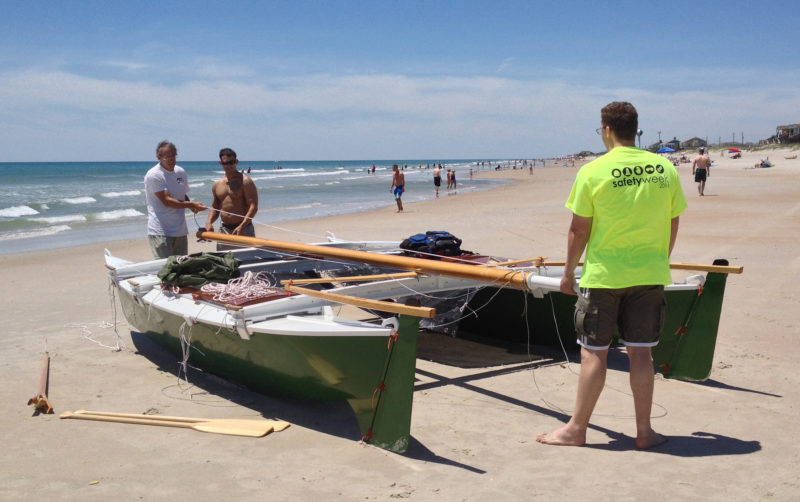
The two hulls and three crossbeams are assembled with lashings instead of hardware. With experience, the assembly time can be cut down to under an hour.
Building the Hitia 17 doesn’t require an large shop, because each hull is only 2′ wide and weighs about 90 lbs. They can be built one at a time under a minimal shelter, on one side of a garage, or, as some builders have done, even inside an apartment or house, as the hulls are slim enough to fit through standard doors, and everything can be moved outdoors and assembled in the back yard. The design book states that the build will take about 250 hours, but most builders take a bit longer if they’re shy on experience and tools or if they simply want better-than-average craftsmanship and finish. I built my Hitia 17 over the course of about seven months of spare-time work, and the result was everything I’d hoped for.
As with the larger Wharram cats, the components and rig of the Hitia 17 are designed to eliminate the need to purchase a lot of expensive marine hardware. The hulls are connected to the three crossbeams with low-stretch rope lashings, and the rudders are laced to the sterns with rope hinges that are both elegant and effective. The tillers lock onto the rudderposts with no metal hardware, and the mast is secured into its step with a wooden key built onto middle crossbeam Even chainplates and mast tangs are unnecessary, as the shrouds and stays are tensioned with lanyards anchored to flat wooden cleats at the sheer at one end and looped over hounds at the masthead on the other.
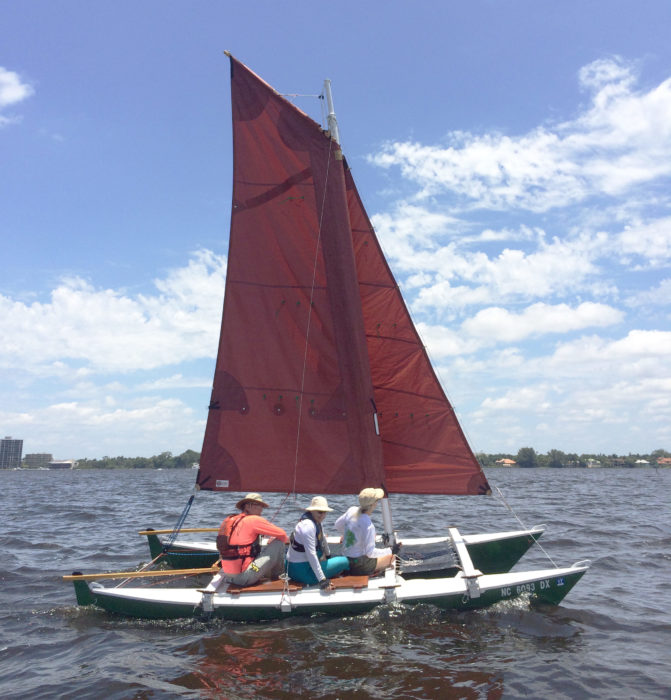
This Hitia 17 carries Wharram’s gaff wingsail main, with a luff sleeve for better airflow around the mast.
When I built my Hitia 17, the sail plan differed from that of the Tiki designs in that it had a sprit rather than the short gaff rig of the standard Wharram wingsail. The sprit has the advantage of simplicity—one less halyard to bother with—and the sail can be brailed around the mast with the sprit in place, but in strong winds, the sprit has to be taken down. It tends to get in the way because it is as long as the boat. Now the Hitia 17 plans include the option for the gaff wingsail, and having sailed the larger Tikis with that rig, I would recommend it as it is easier to reef and offers more adjustment to the shape of the main.
There is no mention of an auxiliary outboard in the building plans, and it’s certainly not necessary, as the boat can be paddled, but I added a motor mount on the aft beam and fitted a 3-hp Evinrude that often came in handy during extended periods of calm on the Gulf of Mexico. The cost of building my own Hitia 17, including the sails, outboard, and a new trailer I modified for it, came in at just under $6,000, which seemed very reasonable for such a capable catamaran.
Unlike the larger Tiki 21 and Tiki 26, the Hitia 17 doesn’t require an elaborate folding trailer, but unlike many beach cats of similar length, it is too beamy at 10’11” to transport fully assembled. Wharram was uncompromising in keeping to the overall beam-to-length ratio of his proven ocean voyagers, and wouldn’t reduce the beam to 8’6”, the maximum width allowed for trailering. But since the hulls are light enough for two people to easily carry or one person to maneuver around with a two-wheeled cart, almost any trailer can carry separated hulls to the water. They could even be cartopped, although with the beams and mast to carry as well, it would require a large and quite substantial rack capable of handling a 300-lb load.
I went to a little more trouble than necessary when fitting out my trailer, because I wanted to be able to assemble and launch the boat fully loaded boat by myself in one go. To accomplish this, I made two removable beams fitted with cradles to hold the hulls at sailing width. Upon arrival at the boat ramp, I secure these in place and then lift the hulls, one end at a time, into the cradles and then lash on the crossbeams and step the mast. With practice, I got my launching time down to just over half an hour.
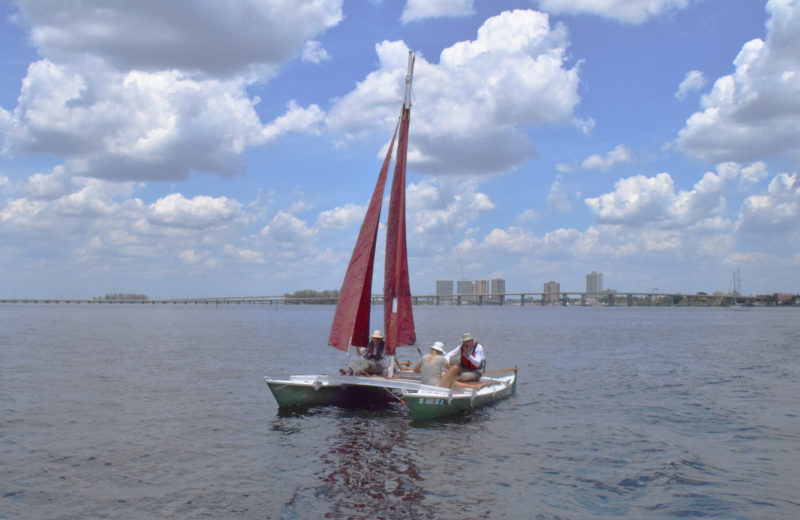
The mast rests on a crossbeam and is supported by a single shroud to each side.
T he Hitia 17 is a forgiving catamaran to sail compared to most beach cats of similar length. With its generous beam and just 160 sq ft of sail area, it is a stable platform that can handle a wide variety of conditions. That’s not to say that it won’t capsize with carelessness, but it is far less likely to than the typical, more racing-oriented catamarans in that size range. Even with its conservative sail plan and relatively low rig, the Hitia 17 is still quite capable of exciting performance in the right conditions. I often clock over 10 knots, even with the hulls weighed down with camping gear. Tacking and jibing are reliable and effortless, and windward ability is certainly acceptable for a multihull designed for cruising rather than racing.
The absence of daggerboards, centerboards, or leeboards somewhat limits the Hitia’s pointing ability, but is a great asset for exploring thin water that most sailboats can’t reach. Drawing only 12”, the deep-V hulls can be sailed right up onto the beach, then easily pushed back off again. On sandy beaches I could even sail in through a moderate surf break and land, just as I did in my kayaks. The rudders and the integral skegs are no deeper than the keels, making it safe to let the boat dry out at low tide. Owners who plan to beach the boat on a regular basis can easily add Kevlar strips or other reinforcements along the keels.
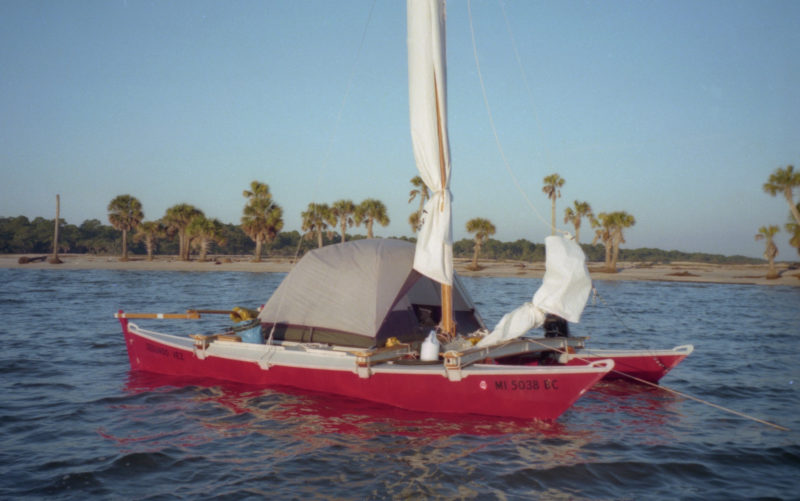
The area between the aft and middle crossbeam is large enough to accommodate a backpacking tent for overnights at anchor. On a trip to St. Vincent Island in Appalachicola Bay, the author camped on the deck and use the front trampoline for a porch, a galley, and storage.
I did several multi-day camp-cruising trips with the Hitia 17 to various barrier islands off the coasts of Florida and Mississippi. The little catamaran performed well whether I was sailing solo or with a companion. I frequently anchored out and pitched a small backpacking tent on the trampoline between the hulls, an arrangement that worked well in calm conditions. There is, however, little room to move about with the tent taking up most of the deck space, so I sometimes found it easier to camp ashore, especially when I had a companion with me.
The flaring deep-V hulls give all Wharram catamarans excellent load-carrying capability for their size, and the Hitia 17 is no exception. Each hull has watertight bulkheads that segment the hull into four dry-storage compartments. Forward of the mast crossbeam, each hull has a large hold accessed through waterproof deck hatches. The plans suggest to either make wooden hatches and coamings or to purchase rubber kayak hatches. I bought a pair of large oval VCP kayak hatches for my own boat, as the foredecks can take a lot of water and spray in rough conditions. In the ’midships section between the beams, each hull has a compartment, accessible through two large hatches, to sit in kayak-style, or to use as foot wells when seated on deck. Spaces beneath these compartments offer extra dry storage for smaller items that will fit through 6” deck plates. Even when loaded with equipment and supplies for a crew of two for several days, there is room to stow lightweight, compact gear securely belowdecks.
Scott B. Williams began his small-boat adventures exploring the creeks and barrier islands by canoe and kayak in his home state of Mississippi. His fascination with the potential of these simple boats led him to longer solo journeys in the Caribbean and down the Mississippi River, which he first wrote about in the pages of Sea Kayaker magazine in the early 1990s. Combining a passion for woodworking with his interest in boats led him into wooden boatbuilding and yacht carpentry while he continued writing about his adventures. He has since written 22 books (and counting), many of them survival and adventure novels which draw on his paddling, boatbuilding, and sailing experiences. Scott can be contacted through his website .
Hitia 17 Particulars
Beam overall/10′11″
Weight total/295 lbs
Weight of single hull/90 lbs
Capacity/550 lbs
Rig/sprit or gaff wing-sail sloop
Sail area/160 sq ft
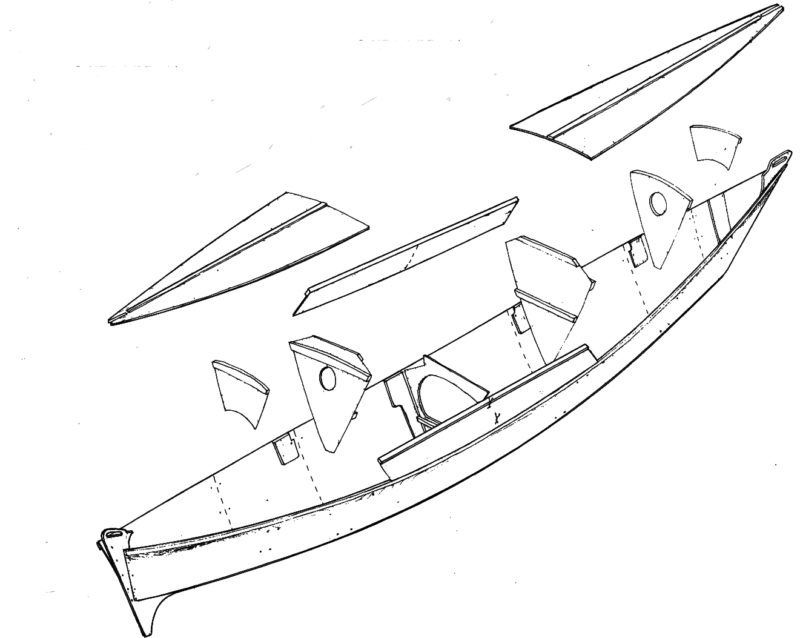
Plans for the Hitia 17 are available from James Wharram Designs for £306 (about $407USD).
Is there a boat you’d like to know more about? Have you built one that you think other Small Boats Monthly readers would enjoy? Please email us!
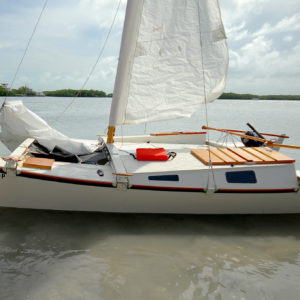
J ames Wharram is a multihull pioneer who has been sailing and designing exceptionally seaworthy catamarans since the 1950s. For his first voyage, he built, TANGAROA, a 23’ catamaran and sailed her from the U.K. to the Caribbean with Jutta Schulze-Rhonhof and Ruth Merseburger, both from Germany. While in the Caribbean he became a father, and the boat mothered a growing colony of teredo worms. With a strong desire to sail home, Wharram built a 40-footer and did the first North Atlantic crossing by catamaran. His designs are based on firsthand experience, regularly updated and improved, and have a safety record that is hard to beat.
I built his Tiki 21, which is designed as an easily built, trailerable coastal cruiser for adventurous folks who don’t mind bearing a small amount of discomfort to be rewarded with a boat which is in harmony with the sea. The plans are highly detailed and provide illustrations for almost every step of the process. The plans include a materials list, down to the last fitting, and an epoxy technique manual depicting everything from laminating to fairing. The plans call for 18 sheets of 1/4″ marine plywood and one sheet of 3/4″. My Tiki 21, BETO, took around 10 or 12 gallons of epoxy and a good helping of mahogany and Douglas-fir.
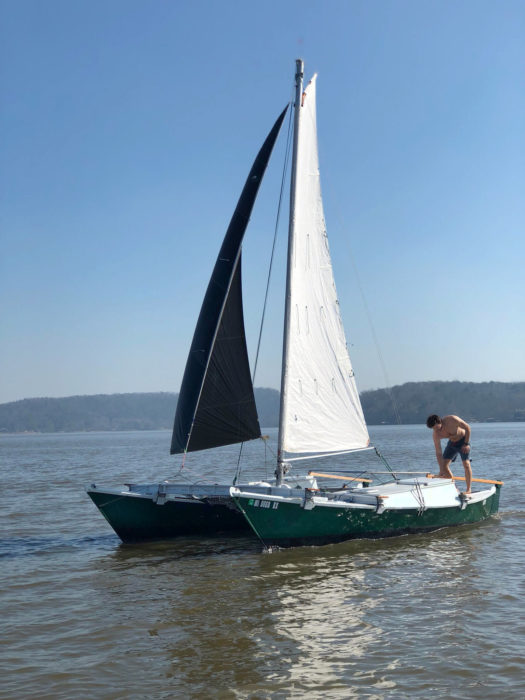
While the Tiki’s main is designed to be sailed with a loose foot, the author finds an easily mounted, aluminum sprit boom provides improved performance in light air.
The hulls are built using the stitch-and-glue method, making it a fairly quick build, even for the first-time builder, though practicing with some scraps of plywood and epoxy is recommended for beginners.
Construction starts with forming the hull panels and stitching them together, then moves on to installing bulkheads and bunks and fitting the decks and cabintops. After the hulls are complete, just three beams, two tillers and rudders, and a wooden mast remain as the last major projects. For BETO, I chose an aluminum mast—a 22′ length of 4″ aluminum tubing with a 1/8″ wall thickness, as recommended in the plans. I chose aluminum over wood in hopes of a lighter mast that would require less maintenance and be easier to raise when rigging.
The Tiki 21’s most controversial feature is, perhaps, the use of lashings, rather than conventional marine hardware, to hold the amas and akas (hulls and cross beams) together. Wharram believes that the lashings allow for shock absorption and decrease shock loads at the joints. Each wrap of the five loops has a 2,800-lb breaking strength. The lashings are frapped so tightly that small movements between structural members are unnoticeable. The lashing system is proven by both Wharram cats and the well-traveled Polynesian voyaging canoes of the Pacific.
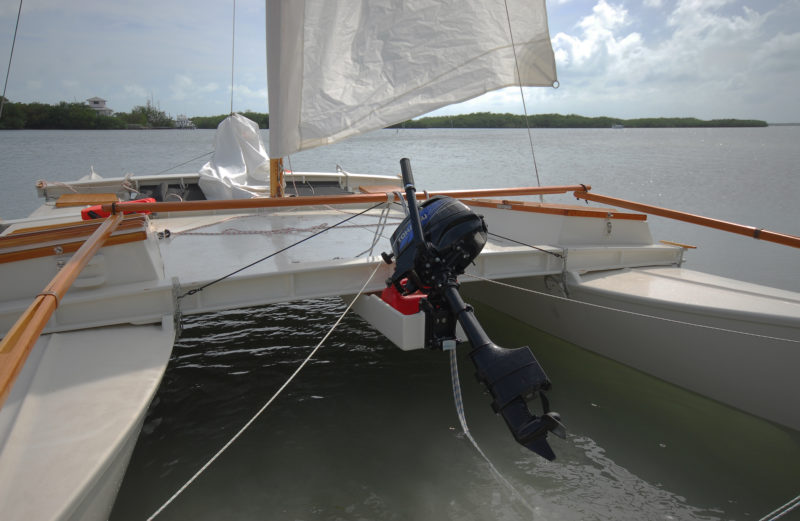
The Tiki 21 plans include a motor mount set within the perimeter of the deck. The pod added to this boat frees up deck space and includes a place for the gas tank. The cross beams, or akas, are stitch-and-glue I-beams.
The Tiki 21 was designed to be assembled on a beach at low tide and to float away when the sea returns. It has a 14″ draft, and each hull weighs in right under 200 lbs when completed. For our negligible tidal range and for freshwater sailing, I chose to build a trailer with telescoping sides that allow the hulls to be expanded outward for boat assembly before being backed down the ramp. We currently sail BETO on a small lake, so it rests on the trailer between outings.
When we want a taste of salt water, we unlash the beams and slide the hulls together for a package that is a little wider than my small Toyota truck. I can assemble the boat by myself in two hours and disassemble it in an hour. This is pretty fast to be on the water, and a helper could easily bring this time down as the lashings and frappings are the most time-consuming tasks. Some Tiki sailors have had good luck with ratchet straps and nylon webbing when trailering to daysail. I wouldn’t recommend ratchets in lieu of lashings for venturing offshore, however.
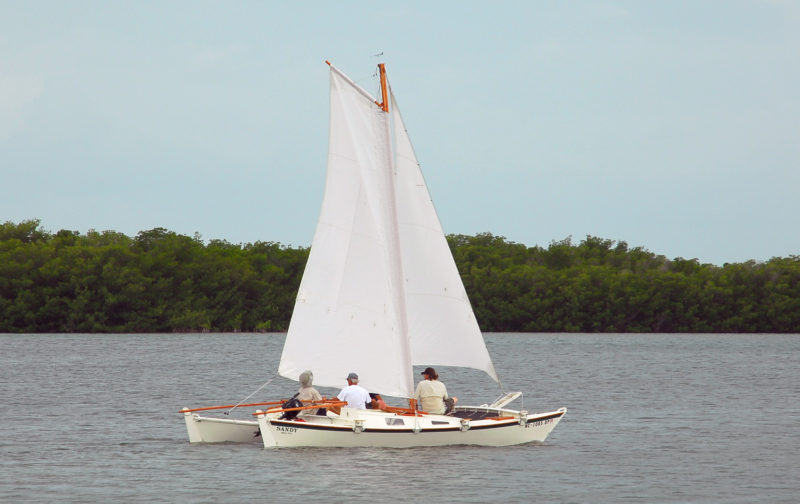
The Tiki 21 was designed with cruising accommodations for two, but there is room for more on deck. The catamaran has a carrying capacity of a half ton.
So how does the Tiki 21 sail? I’m a former racing catamaran sailor whose friends all sail go-fast boats, and I think it sails like a dream! The rig is a Wharram “Wing” sail that keeps the center of gravity low and the power high. The sail is modeled after a high-aspect Dutch gaff rig, using a short gaff at the peak and an elongated luff pocket that envelops the mast and minimizes turbulent airflow. This unique arrangement offers performance similar to modern rotating masts and square-top mainsails without all of the moving parts.
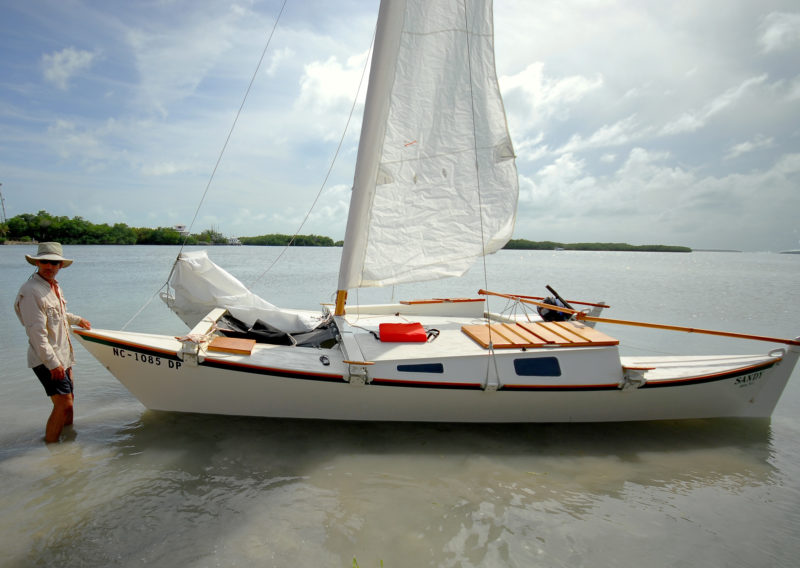
The mainsail is sewn with a luff sleeve for a smother flow of air around the mast. The jib and main halyards run along the mast inside the sleeve. This Tiki 21 was built by Rick Hueschen of North Carolina.
Unlike older Wharram designs, the Tiki 21 has a power-to-weight ratio that can get one in trouble if the wind pipes up. In light air, however, it is slightly undercanvased, and a drifter works wonders. The deep-V hulls have hardly any noticeable leeway if sails are trimmed correctly, and can tack in light and heavy air even sailing just the main.
The rudders are lashed to the sternposts and skegs and do not extend below beneath them, so the Tiki can’t turn on a dime in tight quarters. However, when sailing, it tracks like it is on rails. I sail upwind all the time in up to 20 knots with just a bungee crossed over the tiller. The Tiki is superbly well balanced and will sail along happily with proper trim. To windward we have seen 7 knots with the wind at 50 degrees true, falling down to around 5 knots at 40 degrees true. Off the wind, BETO has clocked 15 knots while power-reaching with no noticeable lifting of the windward hull (check my video ). For normal cruising, we reef the main and jib in 15 knots to keep dry on deck and fully in control while still making 8 to 10 knots on a reach. For sails, we carry a main with three reefs, a jib with one reef, a nylon drifter, an asymmetric spinnaker, and a storm jib. I have an outboard, but I learned to sail on a 22’ engineless racing sloop, so I have plenty of patience when the wind dies, preferring not to deal with a nasty outboard and volatile gasoline. Using a stand-up paddle, I can move the Tiki all day at 3 knots in flat water, and with a second paddler it’s even faster.
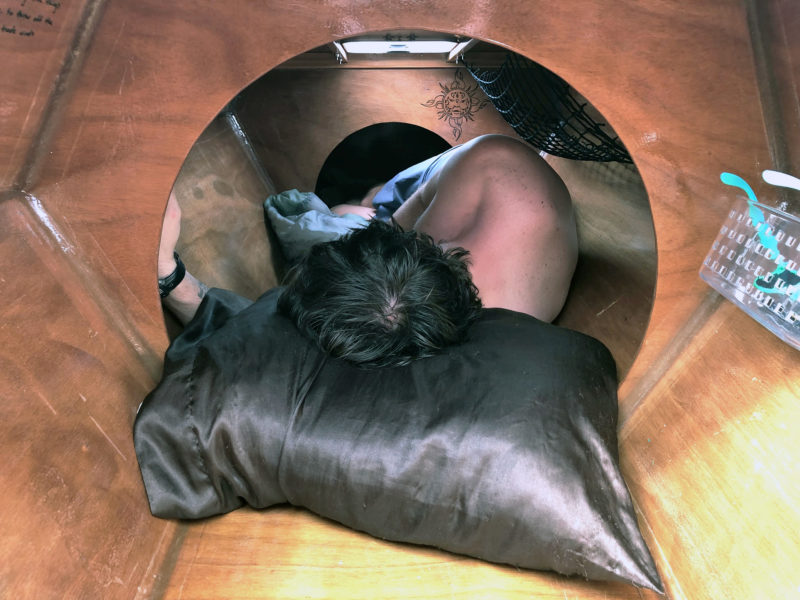
While each hull provides room for a narrow berth, the deck provides more spacious accommodations when equipped with a canopy or a free-standing tent.
For coastal cruising on a small catamaran, one can really not find a better-suited vessel than the Tiki 21. The accommodations inside each hull provide a 12′-long bunk that is 2′ wide; the hulls span 3-1/2′ at the sheer. Our sleeping accommodations are often a two-person tent set on deck, or my girlfriend and I can get cuddly and sleep in one hull if needed. All of the bunks are above the waterline, and under them are the bilges, which provide loads of storage. The load capacity is listed as 1,000 lbs. The bows and sterns all have watertight flotation chambers. The anchor locker doubles as another flotation chamber. The Tiki 21 has six bulkheads in each small hull, making it a strong little boat. Resting between the akas is a plywood deck measuring 6′ x 7′ that never moves far from level when under sail. For my own preference I built a slatted cedar deck instead of a solid plywood one, and it has since been approved by the Wharram Design team.
Rory McDougall sailed his modified Tiki 21, COOKING FAT, around the world in the early 1990s, and until just recently he held the record for sailing the smallest catamaran in a circumnavigation. He experienced gales pushing waves up to 30′, and his boat suffered little damage. In 2010, McDougall sailed in the Jester Challenge, a single-handed transatlantic race for boats between 20′ and 30′, and came in second after 34 days under way, just a few hours after a larger monohull. When in storms, McDougall goes on his sea anchor and reports that the Tiki rides very happily and calmly. In his first gale on sea anchor, he even felt so relaxed that he tied a jibsheet around himself and jumped overboard to swim the swells!
Brad Ingram lives in Birmingham, Alabama, and enjoys sailing, running ultramarathons, and climbing. He spent eight years in 20th Special Forces Group on a small Intelligence team, and he’s now going to nursing school as a civilian. He plans to travel while working as a nurse, making it easy to spend a significant amount of the year traveling in the mountains or at sea. Among all of his recreational pursuits, sailing occupies the lion’s share of his enthusiasm and interest. He mostly enjoys small boat cruises and small, raid-type multihulls. He has a passion for simple, traditional vessels and enjoys sailing sport boats as well.
Tiki 21 Particulars
Waterline length/18′6″
Weight/790 lbs
Load Capacity/1000 lbs
sail area/208 sq ft
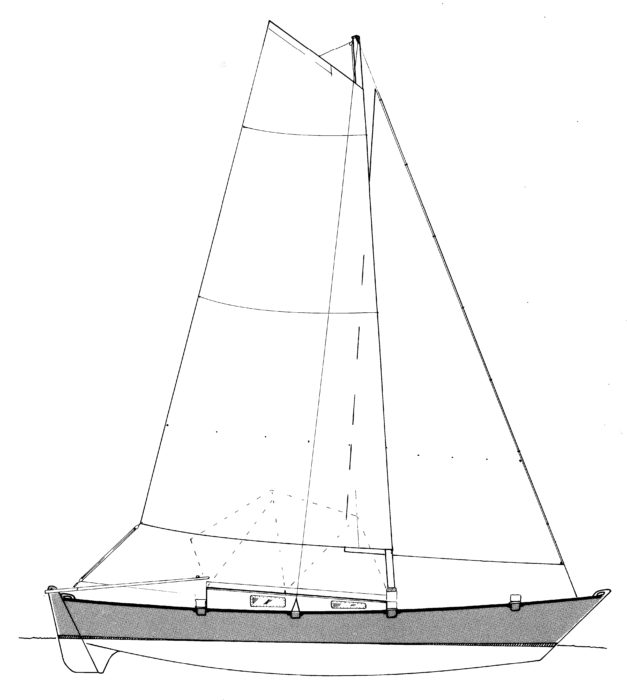
Study plans (£19.00) and full sets of plans (£505.00) are available from James Wharram Designs .
Subscribe For Full Access
Flipbooks are available to paid subscribers only. Subscribe now or log in for access.
- ABOUT THIS SITE
- NEWSLETTER SIGNUP
Monday, January 14, 2008
The wharram tiki 21 catamaran.
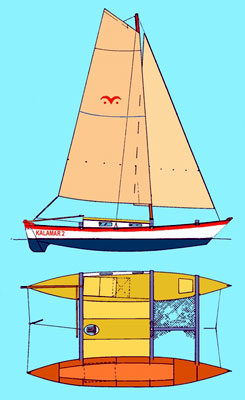
No comments:
Post a comment.
Popular Posts

All Posts by Topic
- wharram catamarans (35)
- boatbuilding (28)
- boat design (20)
- sailing (15)
- voyages (14)
- boat designers (13)
- boat for sale (11)
- kayaking (11)
- boating gear (7)
- book review (7)
- canoeing (6)
- seamanship (6)
- boat buying (5)
- cruising (5)
- launchings (5)
- online resources (5)
- boat camping (4)
- boat refit (4)
- boatbuilding materials (4)
- magazines (4)
- monohulls (4)
- my books (4)
- rivers and swamps (4)
- sailboats (4)
- survival (4)
- Gulf of Mexico (3)
- James Wharram (3)
- boat shows (3)
- sailing fiction (3)
- sharpies (3)
- Cape Dory 27 (2)
- Caribbean (2)
- Carl Alberg (2)
- Kruger Canoes (2)
- Kruger Sea Wind (2)
- Reuel Parker (2)
- boat maintenance (2)
- boat review (2)
- gear review (2)
- marine carpentry (2)
- multihulls (2)
- navigation (2)
- oil spill (2)
- other stuff (2)
- paddling (2)
- projects (2)
- Sailing the Apocalypse (1)
- beachcruising (1)
- book giveaway (1)
- circumnavigation (1)
- cruising destinations (1)
- environment (1)
- expeditions (1)
- great deals (1)
- living aboard (1)
- rowing craft (1)
- the sea (1)
Archive of All Posts by Month
- January (1)
- September (1)
- December (1)
- November (1)
- September (2)
- January (2)
- February (1)
- October (1)
- October (3)
- January (3)
- December (5)
- December (2)
- November (2)
- February (5)
- January (18)
Comparison of two Wharram catamarans
Comparison of two Wharram catamarans – What is the difference between this two catamarans Tiki 21 and Tiki 26. Tiki 21 is the smallest catamaran that was sail around the world, and our Ariki? We try to answer that for you in this video.
In the canal, where Ariki’s home port is, we met a lot of interesting people. There was a colorful group of lovers of the sea and boats. The second year of Ariki’s “stay” in the canal, only 100 m away, another catamaran appeared from the same architect who made the plan for our Ariki.
The truth is that the 6.4 m long Tiki 21 catamaran was first built, and a few years later the architect designed a proportionally enlarged version, which he named the Tiki 26.
Many such catamarans sail around the world. There are only two in my homeland. And purely by chance, the other appeared so close.
It took a few more months for us to meet the owner of little Tiki 21. This is Joe.
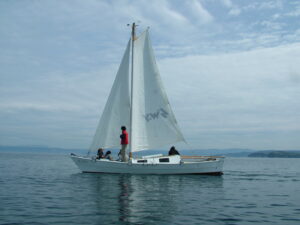
Joe and his Tiki 21
Joe made a catamaran in the hills where he was the caretaker of the hut for some time. He brought him to the valley on foot, in a wheelchair. Each hull separately. He assembled it himself on the shore and after a short wandering came into the canal.
Tiki 26 is exactly the same as Tiki 21. It is only a proportionally enlarged version. Its volume is as much as 60% larger.
The cabin in the hull of the Tiki 21 is small. I could easily compare it to a coffin. Joe is a thin and tall man. It can only lie in the hull if it is stretched. But he can’t turn with his knees bent. If the cab cover is closed, it can only lie down. He can sit with the hood open, but his upper body is looking out of the cab.
The Tiki 26 already has such a large cabin that it is very comfortable to sit in and lie down in.
Another big difference is the cockpit. Tiki 21 has a flat board instead. The Tiki 26 has a large and comfortable cockpit with benches.
The difference between these two boats is therefore quite large. The small Tiki 21 is supposed to be a boat for short coastal trips, and the larger Tiki 26 is a real small cruiser for which there are almost no obstacles in the warm summer months. Such catamarans sail across the Atlantic and beyond.

The smallest catamaran to sail around the world
Even little Tiki 21 isn’t just something. It is the smallest catamaran to has sailed around the Earth. Half that way even without an engine on board.
No, no, it wasn’t Joe! But Joe has just the same catamaran as the one that sailed around the world.
Same speed with engines
Joe is an interesting man. He grew up on the river in a canoe with a paddle in his hand. He started making boats at a very young age. Not for sale. Just for himself. He makes one every year. He has certainly made more than 20 of them. So we never know what his dinghy will be like on the next sail.
Many adventures have lined up in more than a decade-long friendship. We so easily compared both catamarans on sea voyages.
The Tiki 21 has a 5 hp outboard engine on board and reaches 6.5 knots of speed.
The Tiki 26 has a 9.8 hp engine and reaches a speed of 8 knots.
Write below in the comments if you have either of these two boats and have different information. I am very interested in how powerful the engine is and how fast the catamaran goes.
Same speed with sails
Joe and I sailed together in nice and bad weather, along the coast and on the high seas. With Tiki 21 sails, it easily follows the larger Tiki 26. With standard sails for this type of boat, they are completely equivalent.
We sailed together many times along the west coast of Istria. At a distance of 50 NM from the Gulf of Trieste to Cape Kamenjak, we were close together all the time. In winds blowing at 7 to 15 knots into the stern and flank, the catamarans reached the same speed throughout the day.
The next morning we sailed through Kvarner to the island of Susak. We made a special video about this interesting and unique island. The link to it is up here in the right corner.
In the morning we sailed towards the island of Susak in a light wind. When we sailed to Kvarner, we found ourselves in the middle of a rough and foaming sea. The gusts of the bora reached a speed of 25 knots. The two catamarans sailed side by side at the same speed all the way. The first 12 NM slightly to the wind, the next mile to the island slightly with the wind.
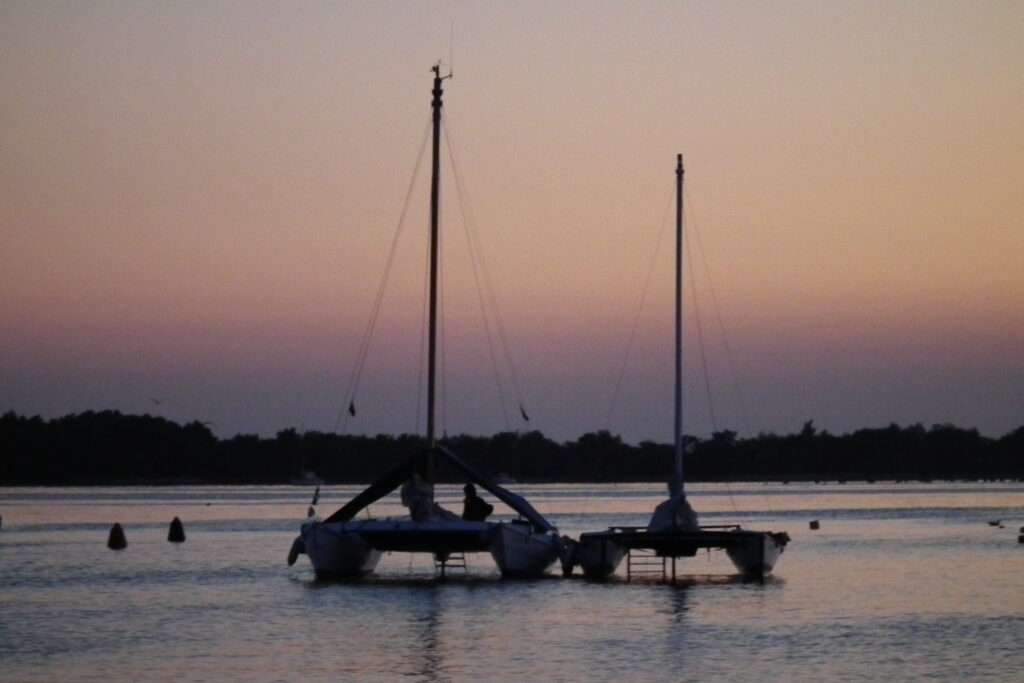
Comparison of two Wharram catamarans Tiki 26 vs Tiki 21
What are the differences
Although catamarans with sails reach the same speed, the differences between them are obvious. At small Tiki 21, one or at most a two-member crew awaits only pure asceticism. At bigger twenty-six, there is already so much space in the cabins and on the deck that this space, although still ascetic, already offers the basic comfort without which it is impossible to imagine a longer stay on the boat.
For us, twenty-six was the right choice. The Ariki catamaran is a boat that is neither too long nor too short. It’s just right for us. It is true that he does not have a double bed but only a single one. True, there is only basic comfort on it. But all of this is only in second place on Ariki. What matters most is its navigability. These, however, surprise us again and again.
The conclusion is the same every time: Wharram catamarans are obviously capable of anything their captains dare.
Related Posts
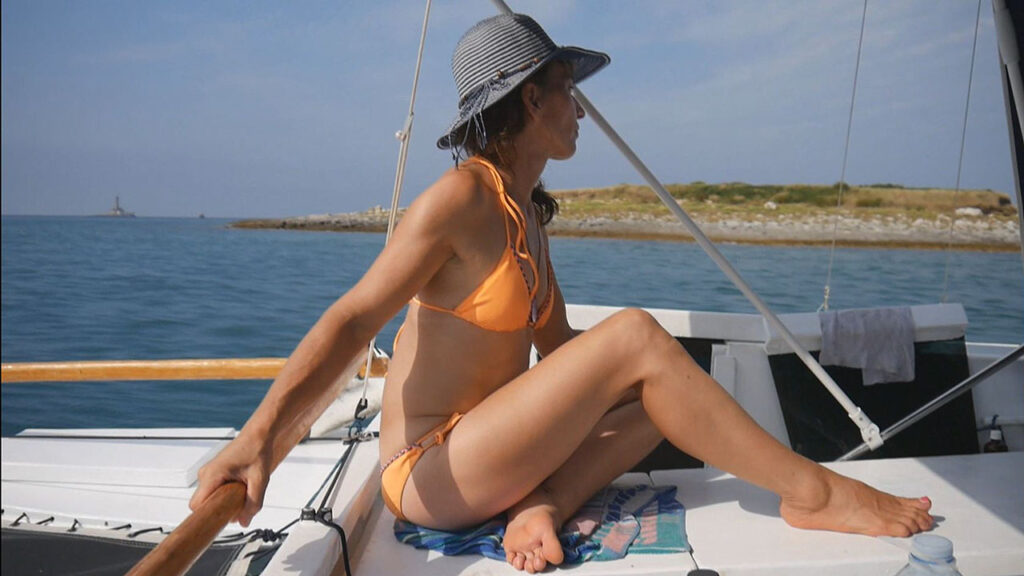
Comparison of Double Canoe vs Sailboat
Comparison of double canoe vs sailboat – We will limit ourselves to a comparison between…

Elastic the Cheapest Autopilot
Elastic the cheapest autopilot - That’s why today’s video is dedicated to the elastic, which…

How Catamaran Ariki Got Name
How Catamaran Ariki got name is the story of a boat that has at least…

Catamaran ARIKI Building Cost
Catamaran ARIKI building cost. If you are interested in why our costs exceeded $24 k…

The dodger on an Open Deck Catamaran
The dodger on an open deck catamaran is the only protection against wind, rain and…
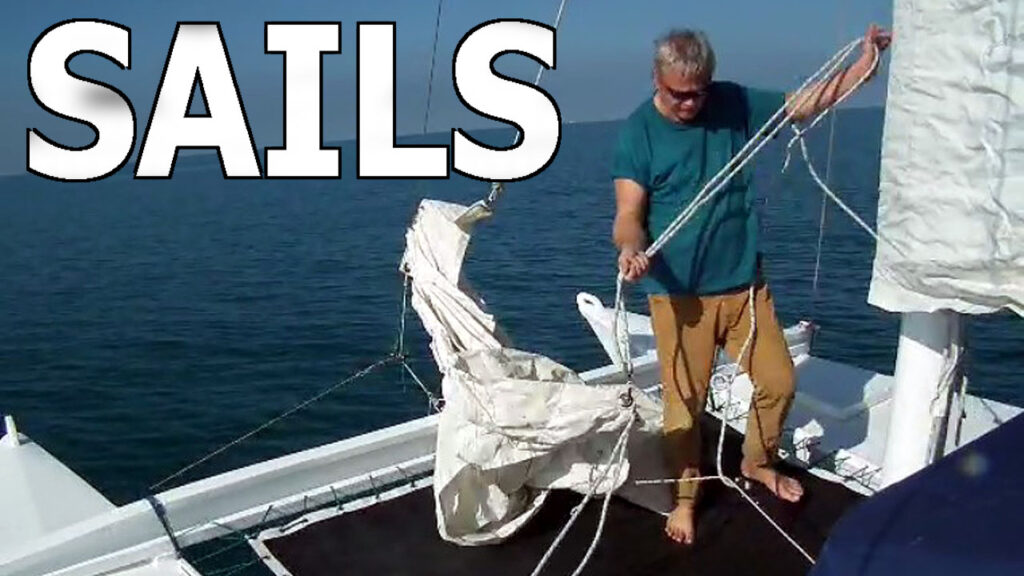
Catamaran ARIKI Set Sails
In this video we will show you how Catamaran ARIKI set sails and what kind…

Catamaran is held together only by the ropes
The catamaran is held together only by the ropes. It is equipped with 500 m…

Lowering the Sails in Real Time
Lowering the sails in real time is a video in which you can see how…

Build the model
I first built a real Wharram catamaran 26 feet long and after quite a few…
Leave a Comment Cancel Reply
Your email address will not be published. Required fields are marked *

Best Nightlife in Moscow
Local recommendations from our my guide moscow team.
They say ‘Moscow never sleeps’. Having seen Moscow’s night scene only once, you are sure this saying is absolutely rightful. Best night clubs with world-known DJs tune up the capital’s audience every night; lounge bars with high-quality hookah and professional staff create relaxed and cozy atmosphere all night long; and, of course, clubs for men, where stunning and gorgeous ladies take you away from routine and busy life of metropolis. Exciting, modern, crazy...it's Moscow. Read more about nightlife in Moscow.

One more beer and wine
They say tastes differ, and that’s true. Favourite food for each of us is dishes we love. One More Beer & Wine Bar’s menu is a combination of offers to cater each...

A newcomer on Moscow's restaurant scene, Gastro Pub Chelsea brings a fresh breath to the city's pub culture. Named after London's elite Chelsea neighborhood, this exquisi
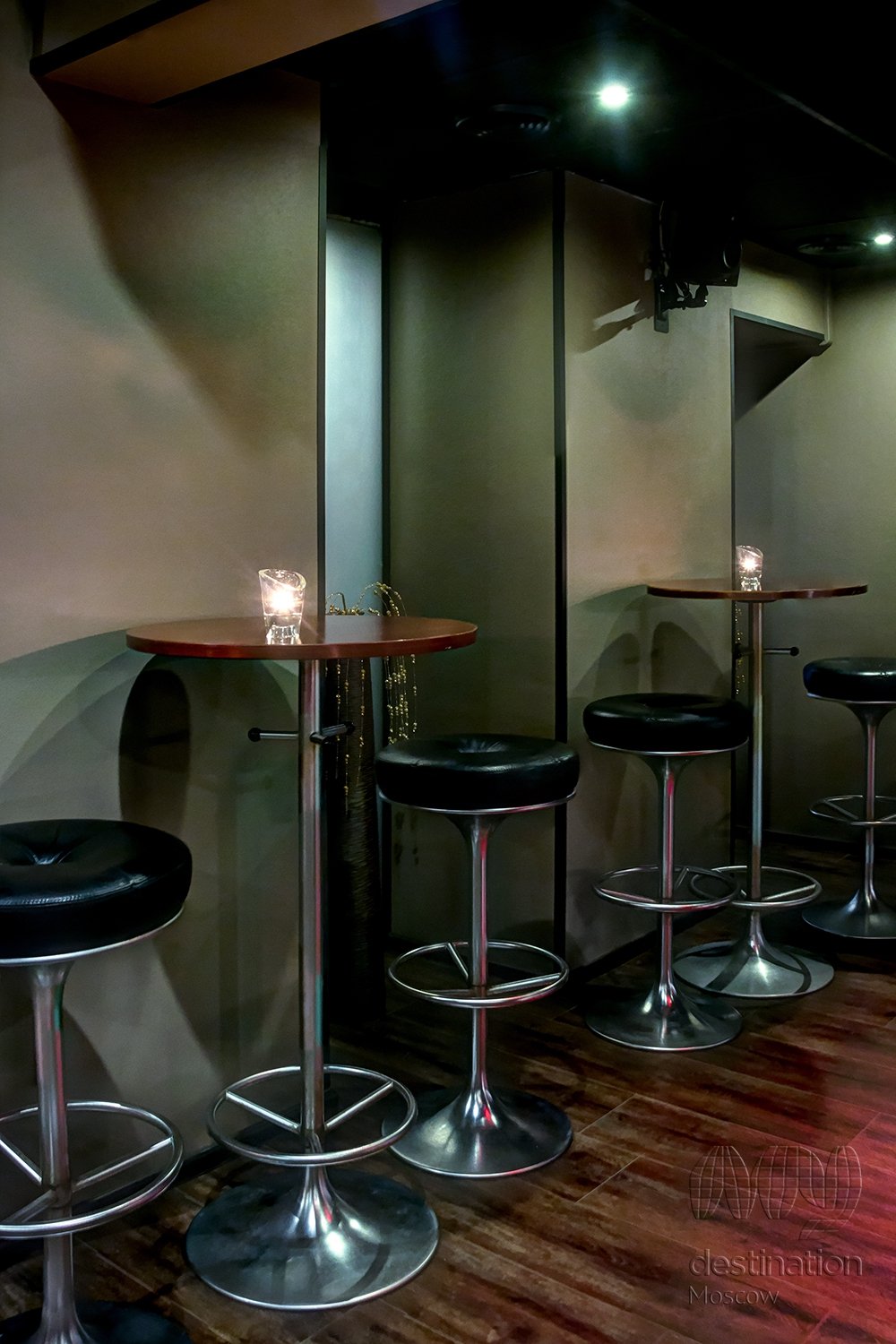
Night Flight
'Quite simply the best place to be!' It is no surprise that exactly these seven words are used as Night Flight's slogan.............

Propaganda was one of the first dance clubs to open its doors in Moscow and is still very popular today. It is a student hang-out thanks to its reasonable prices and more

16 Tons Club
16 Tons is in the centre of Moscow and successfully combines 3 different kinds of entertainment: clubbing, boozing up in a pub and satisfying your gourmet taste at a rest

The Gogol’ cafe-club offers separate nightclub and restaurant areas in a casual and cosy atmosphere and internal decor. The emphasis here is on alternative rock with bo

Rasputin is, probably, Moscow's best known men's club, known for turning the art of striptease into erotic theatre in its own right. Rasputin has numerous awards to its n

English cuisine is very delicious, beautiful and very much home-style. Do you think it's not? To check it, you don't even need to travel all the way to the UK. A good old

Artel Bessonnica
Artel Bessonnitsa is a unique unheard-of format of night club in Moscow. It's more than just a night club, it's a space of unlimited joy, love and fun, where each member

VANILIA SPA for men
Massage was born in Ancient Greece, and since that times the upper-class society was known to be fond of massage procedures. It’s not a secret what a great impact on he


F-lounge cafe
F-lounge cafe has found its place in the most popular district in Moscow: Chistye Prudy (Clean Ponds). Quality, taste and professional staff...

Legendary karaoke has seen a revival and found its place on famous Tverskaya Street in the very heart of Moscow, in luxurious and mysterious mansion. Cozy atmosphere and
Create New Guide
Mini guides.
Login to create your guides for Moscow.
Add to My Guide
- Add to New Guide
Recommended Experiences in Moscow

USSR History, Mosaics Arts, Soviet Architecture & Statues
Walk through the Soviet Historical Era of Bishkek of Soviet Kyrgyzstan. Explore Soviet architect Buildings, Statues and Touch the mosaics art which were applied in the decades between the 1960s-1980s.

T-72 Tank Driving Heavy Metal Experience
You'll have the opportunity to drive a T-72 tank under the guidance of a professional instructor who will provide you with expert instruction and safety briefings before you get behind the controls.

T-55 Tank Driving Heavy Metal Experience
You'll have the opportunity to drive a T-55 tank under the guidance of a professional instructor who will provide you with expert instruction and safety briefings before you get behind the controls.

Massada and the Dead Sea in Russian
Massada and the Dead Sea – A journey to the lowest place in the world.

Moscow suburb and Central Market
One of the oldest and architecturally most valuable places in Riga is the Moscow Suburb, which first emerged just outside the walls of Riga in the 13th century.
Search, Compare, and Save up to 70%!
Local car rental comparison with my guide, free cancellation.
No need to worry if your plans change with free cancellation options available
24/7 Customer Service
All of our providers offer 24/7 support
500+ trusted car hire partners globally
Create & share your own guide to moscow with friends and family.
Add your recommended places to visit by browsing the website and pressing the icon.
Create your own guide of favourite 'must see' places
Earn your Local Expert badge by Sharing your guides with others
Get your guide seen by submitting it to the Mini Guides section
Must See Places For First Timers
Handpicked by a Local Expert

Places to watch the FIFA World Cup 2018

Best For Kids

We Are Part of the My Guide Network!
My Guide Moscow is part of the global My Guide Network of Online & Mobile travel guides.
We are now in 120+ Destinations and Growing. If you are interested in becoming a local travel partner and would like to find out more then click for more info about our Website Business Opportunity .
Nearby Destinations
- My Guide St Petersburg
- My Guide Warsaw
- My Guide Gdansk
- My Guide Stockholm
- My Guide Krakow
- My Guide Slovakia
- My Guide Budapest
- My Guide Copenhagen
- My Guide Berlin
No results found
- Adult Entertainment
- Hookah cafe
- Karaoke Bars
- Live Music Bars
- Night Clubs
- Kitay - Gorod Moscow
- Kuznetsky most Moscow
- Moscow City
{[{item.label}]}
- {[{data.title}]}
Events in Moscow
Filter Events by Sub-Category
- This Weekend
Please select a Date first.
Gallery Yusupov Art
- Belorusskaya • 10 min walk

Also popular with travelers

Gallery Yusupov Art (Moscow, Russia): Hours, Address - Tripadvisor

James Wharram Designs
Search Our Site
- Self Build Boats
- Professionally Built Boats
- Choosing a Boat
- How We Design
- Photo Gallery
- Video Gallery
- Articles & Blogs
Wharram World
A global family of sailors.
The Wharram World circles the globe. Wharram catamarans have been built and are sailing in all the World's oceans and can be found in far away ports and anchorages.
With over 10,000 sets of Plans sold since the 1960s this is not surprising. Many of the builders and sailors of Wharram catamarans are now writing blogs about their exploits and publishing films of their boats sailing. Many have done amazing things with their boats. Some are offering their boats for charter.
This information is gathered here to share with people new to the Wharram World. Learn about what others have done, get inspired and start your own life of adventure on the sea!

Boat Launch Spotlight
Stories from wharram sailors.
- Lapita Voyage
- Polynesian Catamaran Association
Wharram Community On The Web
- Short Story Competition

Your Wharram catamaran helps you to connect.. The best part of our Greek adventure has been the people; the meetings; the new friends.. just wonderful. And having a Wharram catamaran really does a lot when it comes to meeting new people. Locals, fishermen, tourists... all ages.... they all get attracted to the boat. They all see it as a traditional boat, and they have so many questions. We have also had lots of old seamen and fishermen on the boat giving advice and tips on local weather and harbours. Truly amazing. We have learned a lot from these very skilled and experienced seafarers. And also here our Wharram helps; they see it as a proper seagoing ship. - Jens-Einar Storheim
Tiki Odyssey

From Kos to Kefalonia. Father and son, in a self-build Wharram Tiki, survive a winter passage across Greece. The call came on Thursday. "Hey, Dad. There's a weather window, all next week. It could take us all the way to Monemvasia, maybe even round the Peleponese." Our plan was to sail our self-built Wharram Tiki 26 from its birthplace in Kos to its new home in Kefalonia, a winter passage of over 400nm east to west across Greece. A compelling read.
Melanesia Uri Aha, Queensland
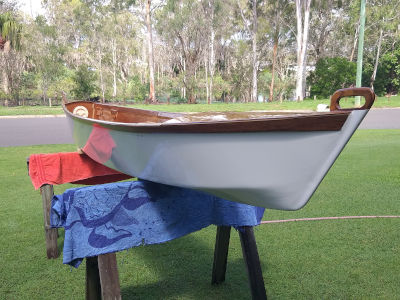
I was prompted to email you and let you know what a wonderful craft my Melanesia 16 has proven to be. Some of my adventures have been a little on the edge of a small canoe's capability but she hasn't let me down.
Building Kiski, a school project to build a Melanesia

I am a freshman at The Kiski School, an all boys private boarding school located in Pennsylvania. In my Survival Arts class this semester, we spent nearly a month piecing together the Melanesian Outrigger Canoe. The plans for the canoe were very easy to follow. The pieces all fit very well with one another to the point where we had no issues putting them together. Each of us had an enjoyable time learning how to build a boat.
Building Neuro, a Hitia 14
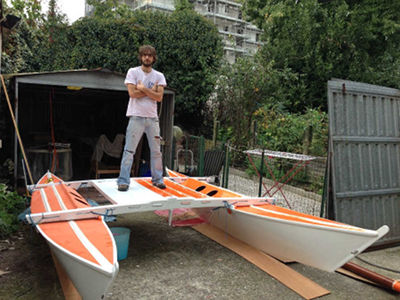
Work began in July 2013 with the delivery of the plywood and timber: Okoume marine plywood and two large planks of Mahogany. We worked on Neuro during the weekends and during our free time after work on weekdays. We only had few machinery so we did most of the work by hand. It was the most satisfying experience to see Neuro take shape as we progressed.
Storm Tactics On Wharram Catamarans
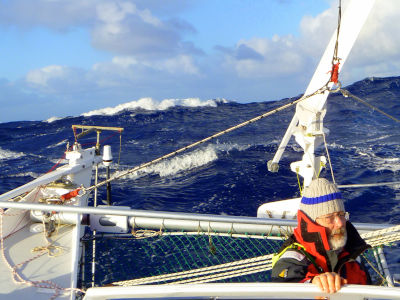
Don Brazier, Wharram agent in New Zealand and owner/builder of a beautiful 41 foot Narai Mk IV, has been collecting accounts from many Wharram sailors who have experienced severe weather at sea. He himself has made a number of voyages in the Pacific and encountered severe weather, in which he deployed drogue and parachute.
Letters from Tiki 46 'Peace IV'
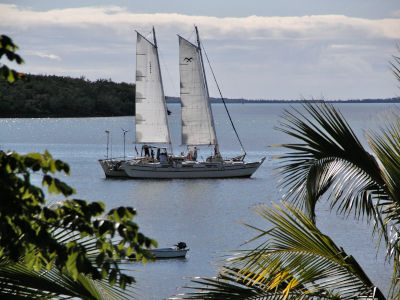
The first Tiki 46 was built by Ann and Neville Clement, two experienced single-handed ocean sailors. Upon completion they crossed the Atlantic and now make a yearly migration up and down the USA East coast. Ann has written regular updates on their travels, interesting experiences and improvements to their boat.
The Katipo Voyage - Pacific Voyage On A Narai Mk4
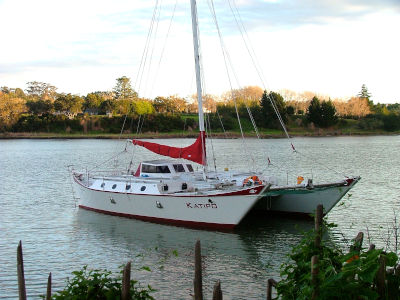
This is an account of Don's latest voyage in the Pacific: "It was a wild, rough night but Katipo's bows rose to the large, steep phosphorescent capped waves with ease. It was like sitting on a roller coaster at a fun park but if you peered out from behind the shelter of the deck pod you were blasted by cold wind and spray."
Pahi 42 Mother Ocean's Lesson In Survival
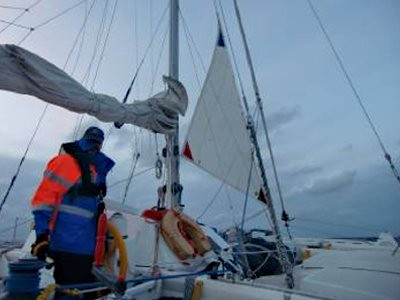
"Survival is, as a matter of fact, Mother Ocean's middle name. Her talent for it is baffling: Being among an estimated 700 boats on the hard in Grenada in autumn 2004, she was one of the precious few to come out of the carnage of hurricane Ivan without visible damage, save one solar panel that came off at the height of the storm".
Building And Sailing a Tiki 38 In South Africa
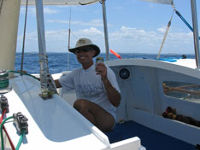
"She had taken me 3 years to build in a warehouse in Durban, South Africa. I have not sailed a large boat single or short handed so it was with some trepidation that I took Dragon on her first cruise in December 2004 to Richards Bay."
Tiki 38 'Dragon' Sails To New Zealand
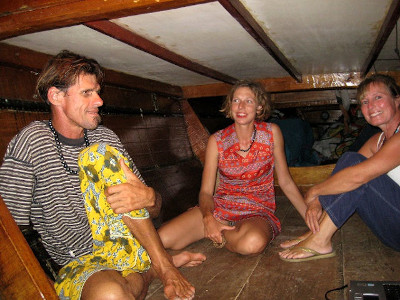
"Plenty of water has passed under Dragon's keels since I last wrote to you. In January 2009 Dragon and I left I our home port of Durban, South Africa for New Zealand. We had stops in St Helena, Fernando de Noronho, Forteleza and Grenada. Dragon has proved herself to be a magnificent boat."
The Wharram name is legendary.. Many, many thanks for all you've done for the global sailor's world of sustainable, practical, and beautiful sailing. The Wharram name is, and will remain, legendary. - Norm

The Lapita Voyage
The Lapita Voyage began in 2008, when two 38ft double canoes , designed by James Wharram Designs, based on an ancient Polynesian canoe hull-form and built in the Philippines, set out on a 4,000Nm voyage along the island chains of the Philippines, Indonesia, New Guinea and the Solomons.
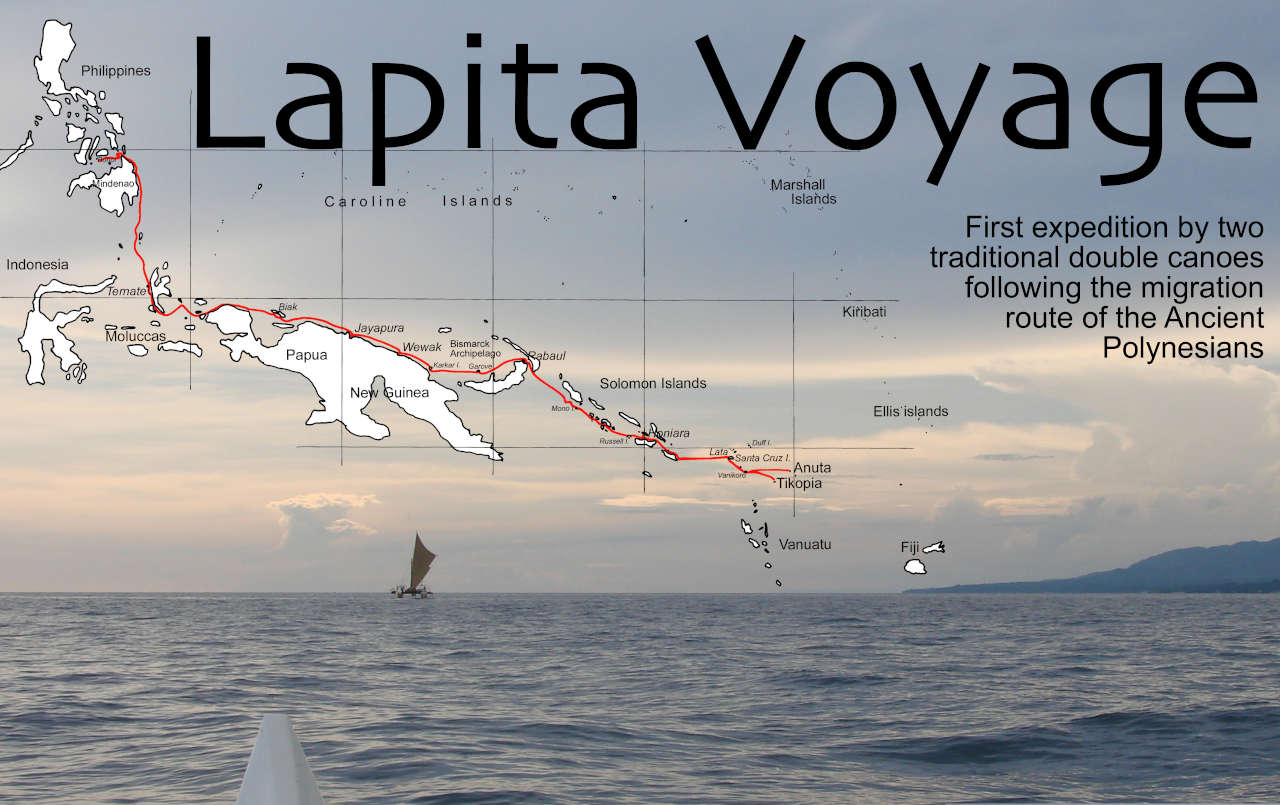
Their destination was Anuta and Tikopia , two tiny, remote islands at the Eastern end of the Santa Cruz Islands, where the boats arrived in mid March 2009 and were donated to the islanders for their future inter island voyaging.
The 'Lapita Voyage' was a major expedition in Experimental Marine Archaeology. It was the first exploration by Ethnic sailing craft of one possible migration route into the Central Pacific. The voyage was made entirely under sail without motors , using traditional Polynesian crab claw sails and steering paddles.
The Polynesian Catamaran Association
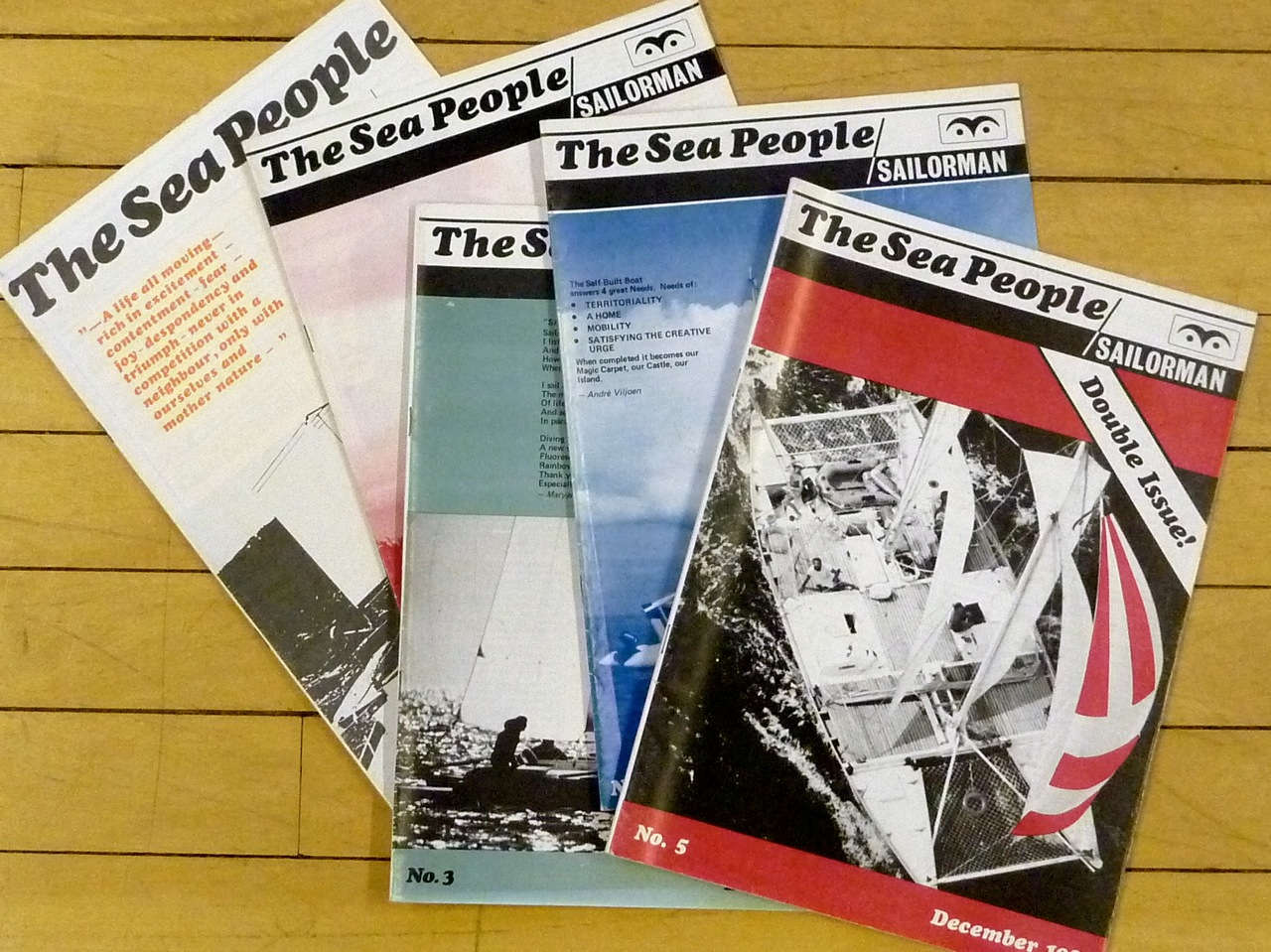
The Polynesian Catamaran Association has been a voluntary club for people interested in the designs of James Wharram since 1967. Due to a direct request from James and Hanneke an archive of all the past PCA publications has now been created, and made available on-line. We hope you enjoy reading all 75 of The Sea People magazines!
Community Discussion
For all friends and sailors of Wharram Catamarans. A very active Facebook group of over 7000 members. This Facebook group has taken over where the Polynesian Catamaran Association left off. Do join them.
Another very active Facebook group. Wharram Tiki design: 21' to 46'. Share your questions, thoughts, ideas, advice and stories. Sell your boat, or find a Wharram Tiki for sale.
A Facebook group dedicated to the smaller catamarans in the Wharram range.
Our forum is now closed to new submissions, but still contains a lot of useful information.
Facebook group for the HUI Wharram gathering in Florida, United States.
This association was born from the passion for sailing and the self-construction of original boats among some friends who live near Lake Bolsena. Facebook group.
A photo discussion forum for Wharram Design Enthusiasts.
Sales, news and blogs: A place to find information about James Wharram catamarans for sale, gatherings, launches, builds, blogs and links. This website is maintained by Boatsmith, Wharram's authorized US builder.
Builders and Sailors
Follow the building and sailing adventures of this beautiful self build Tiki 38 - built in Poland.
Photos of Wharram Hitia 17 catamaran ' Star Catcher ', by John Hughes. These photos really capture the spirit of adventure that the small coastal trekking Wharrams can offer.
Following a long time dream, I set sail in April 2019 in the south of France. My new home is a 26 feet sailing catamaran built out of plywood. The boat design follows the rule: keep it as simple as possible. This has the advantage that one is closer to the ocean and also that there are fewer and cheaper repairs than usually on a sailboat.
I have always been a big fan of self sufficiency, liked being outside of the main stream, and loved DIY projects. My mind got set for another big adventure that I think will change my life once again. I get highly excited about it and will be writing about it in more details here.
Melanesia being built at the Smithsonian National Museum of the American Indian (NMAI) as a practical example of outrigger canoe building.
Building, sailing and maintaining Hitia 17 'Lilla My'. A great step-by-step picture blog.
Dedari Nyuh Kuning was built in the village of Nyuh Kuning on the beautiful island of Bail. It's a Wharram Hitia 17, a 17 foot Polynesian style catamaran in stitch and glue technique.
Documenting the construction and sailing adventures of a Hitia 17 beach cruising catamaran.
Shaun converted his Tahiti Wayfarer outrigger canoe 'Wilber' into a double canoe and travels around the Gulf intracoastal waterway.
Photo blog of assembling and launching Tiki 21 'Itatae'.
Adventures of a Small Green Catamaran.
Construction and voyages of a Tiki 21 in the Pacific northwest, USA.
A blog on sailing and maintaining a Tiki 21, San Francisco Bay.
Brad's writings about building and sailing 'Beto'.
Picture blog of the restoration and sailing of Hinemoa 'Tuatara', New Zealand.
Building a beautiful Tiki 26 in the Philippines.
Documenting the construction of a Tiki 26. In Portuguese.
Building a Tiki 26 in Mississippi, USA.
The construction and sailing of Tiki 26 'Tsunamichaser' in the Pacific north west, USA.
The story so far of Anette and Manne Gehrken and their Tiki 30 in Greece.
Rogerio's account of building 'TikiRio'. In Portuguese.
Photos of building and sailing Tiki 31 'JoJo'. Also included is information on building costs, equipment and materials, as well as logbooks.
Building a Tiki 31 in Crete.
Life on a self built Tiki 38 catamaran, built in England.
Aluna is a Tiki 38 built in California by Beat Rettenmund. He is using a Crabclaw rig.
Diary of a first time boat builder in Kent, England.
A build project in Canada.
Building a Pahi 42 in 18 months and sailing her in the middle east during the first Gulf war.
Documenting the building of a Tiki 46, France.
Projects and Expeditions
A home built Tiki 21 with a mission: clean plastic litter from the sea. 'Itatae' was built in Estonia and now sails in Croatia. Also includes a blog about the building process.
Rory McDougall entered Tiki 21 'Cookie' into the single-handed trans Atlantic 'Jester Challenge' 2010. You can follow progress on this blog site.
Rory McDougall discusses his solo circumnavigation of the world in Tiki 21 'Cooking Fat' in this series of audio podcasts.
The Tiki 38 'Mon Tiki' eco catamaran project is a self-sustaining, for profit business serving the summer visitors to Montauk.
Captain Kiko Johnson is a sailor and experienced boat builder specializing in traditional Hawaiian canoes made by hand. He is building one of the Child of the Sea - Tama Moana designs.
First expedition following the migration route of the ancient polynesians on two Wharram ethnic 'Tama Moana' designs. James Wharram and Hanneke Boon were part of this voyage from the Philippines to Tikopia and Anuta. In English and German.
Largyalo is an enlarged Pahi 63, she is bound for a round-the-world voyage of several years. Universities and Institutes are invited to engage and accompany research projects. Due to her self-sufficient energy supply system, this vessel represents an ideal setting for environmental projects. In English and German.
Organisation monitoring the health of the oceans and reefs of the world. Will be using an Islander 65 as mothership when enough finances have been raised. Invites other Wharram cat owners to join.
Planet Ocean is the latest project of Sonja Napetschnig and Tom Puchner. They have enabled thousands of students and young people to discover and learn to love and respect the sea. At the heart of Planet Ocean is our 52ft Wharram catamaran - the only carbon neutral, self sufficient, noiseless diving boat in the world.
Exploring the coast and islands of the curious Sea of Cortez on a Tahiti Wayfarer - to get to know the waters, landscapes, wildlife, and people that make the area so special.
Dragongate is now telling the story of a family sailing adventure aboard a Wharram 26' Pahi across North America (by trailer) through Florida, across the Gulf Stream and through the Bahamas.
Blog by live-aboard sailors of Tiki 31 'Kahuna' in Brazil. In Portuguese.
Follow Glenn Tieman's solo adventures around the Pacific on his self built Wharram ethnic boat 'Tama Moana'.
Follow Peter, Alexandra and their son Finn on their round the world voyage on a 40' Narai Mk IV. In German.
Blog of a liveaboard family's experiences sailing the world. In French.
Follow the adventures of Ariki 'Piggy' from Vancouver Island to Hawaii, south to Tahiti/French Polynesia, and across Polynesia to New Zealand.
Sail Beluga provides a uniquely personal and relaxing way to experience the turquoise waters and white sandy beaches of the Turks & Caicos Islands. Beluga is a 40ft sailing catamaran available for half and full day private charter experiences from Providenciales. What could be more romantic than sailing in the tropics on your own private catamaran?
Catalpa is a beautifully built Pahi 42. Cyril and Manon run day charters out of Port Louis in Guadeloupe. They can take small or bigger groups of people for day sails with lunch. Hanneke has sailed on Catalpa on one of their day charters and can recommend it. If you are on holiday in Guadeloupe and would like to experience sailing a Pahi 42, this is an ideal opportunity. Catalpa was built in Germany in 1995 to a very high standard. Photographs of her taken in 2003 in Corfu can be seen in our gallery .
Join us on 'Taboo' and enjoy a morning full of discoveries on the north coast of Moorea. You'll be guided trough the unmistakable Cook and Opunohu bays to admire their lush tropical vegetation. You'll enjoy the tranquility, gliding over the various shades of the blue lagoon, navigating along the reef for a panoramic view of Moorea.
Cruise on a Wharram Pahi 42.
If you like the idea of a yacht charter during which you will find uncrowded cruising grounds, a great variety of stunning scenery, a balmy tropical climate, blue water, white sandy beaches, brilliant snorkeling, fabulous food, a very friendly welcoming population and lots more, then you really should consider a sailing charter on the Andaman coast of Thailand.
Sailing around the archipelago of Lamu, between beautiful wild islands, lagoons and coral reefs, on a Wharram Pahi 63 'Kaskazi'.
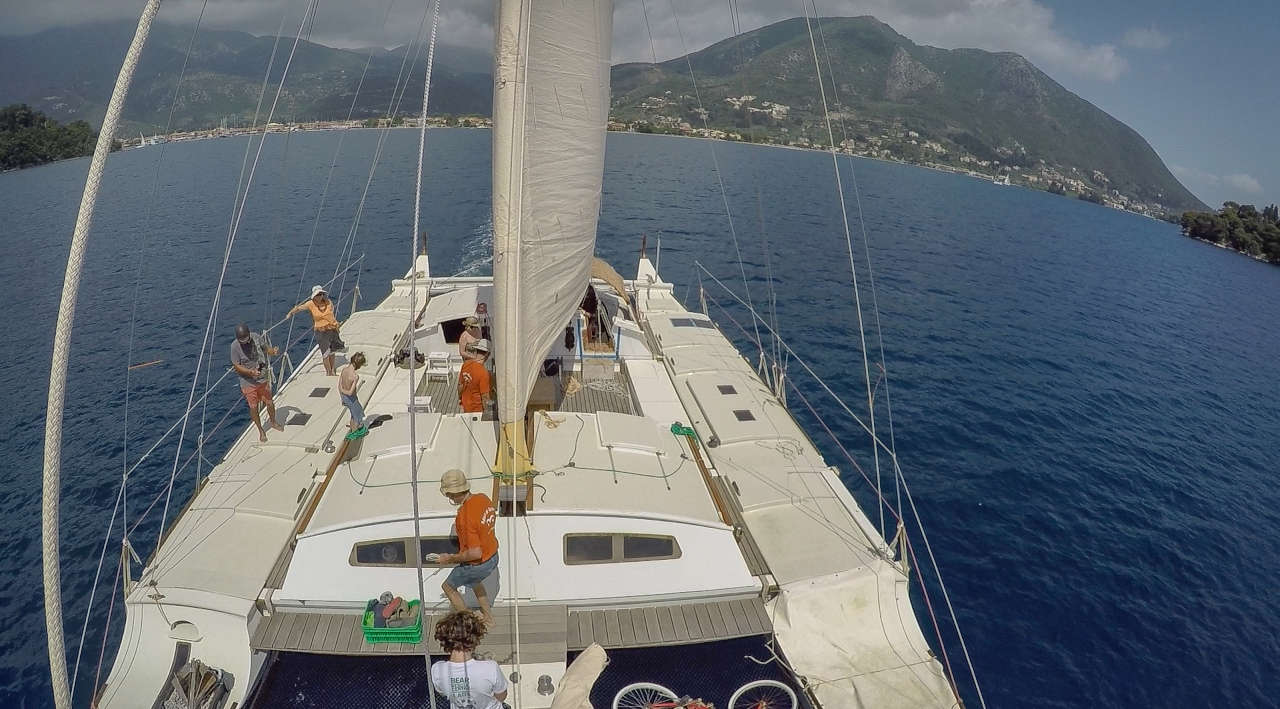
Respect for the brilliance of a holistic approach in Wharram design.. Hello, the purpose of this email is to express my respect and compliments to James and Hanneke. I have been researching their designs for two years now and I have read many blogs and comments and seen many pictures and videos from builders and sailors. I recently received building plans for a Tiki 26 #454. I bought my first sailing Dinghy when I was 14 years old and now that I am 62 I am still sailing nearly everyday in my Prindle 15 or my Tornado catamaran on the northsea coast at Ter Heijde about 5km north of Hoek van Holland in The Netherlands. I understand sailing boats and catamarans better than nearly everyone around me and so I understand the many challenges and pitfalls and scams in designs. Reading on the internet I see even experienced builders lack the knowledge to fully respect the brilliance of a holistic approach in design architecture and the high standards of safety in the Wharram designs. Therefore I wish to express my gratitude and respect to James and Hanneke. - Alfred Daniels
The Short Story Competition
In 2004, we ran a storing writing competition. Due to the very high standard of most of the entries submitted, the three finalists were very close in the final scores. Therefore, after much deliberation, we decided to award prizes to all three finalists for their excellent stories. The winner's prize was awarded to the two entries that tied for first place and a 'runner up' prize to the story that scored so close to the winners.
Winner #1 - Thomas Hembroff, Canada
For his outstanding story: ' Stick To The Plans '. Congratulations Tom, you have awarded one of two winner's prizes: a set of Tiki 21 Building Plans and a Winner's Award Certificate signed by Ruth Wharram.

Tom's story ' Stick to the Plans ', is set in the 1970's during the 'shakedown' voyage of the Ariki 'Piggy'. Tom and his brother Don, after having completed the building of their boat they set off on a voyage around the world. All goes well and they pick up a hitchhiker, an artist, who wants a ride to their next destination, New Zealand. The voyage to New Zealand is a very dramatic and dangerous leg of their journey. The fact that their fate hangs on a knife edge is revealed through the reactions of their artistic passenger. Read this well-crafted story to share the excitement of this harrowing voyage.
Winner #2 - Loretta M. Thwaite, Australia
For her outstanding story: ' The Wharram Hunt '. Congratulations Loretta, you have been awarded the other winner's prize: a set of Tiki 21 Building Plans and a Winner's Award Certificate signed by Ruth Wharram.
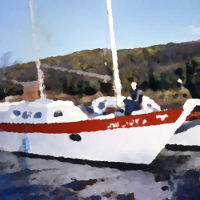
Loretta's story ' The Wharram Hunt ' is a set in a small coastal town on tropical Queensland, Australia. The story is told in an amusing and sensitive way of a woman, who having settled in this town, is invited out for a cruise by a middle-aged friend and his two buddies. She is not overly impressed by the comfortable cruise on the pleasure craft, but is subsequently introduced to a new perspective on boats by another friend who dreams of building a Wharram. The intriguing story then unfolds of the 'hunt' for a glimpse of a finished Wharram so that the dream can be distilled into the purchase of a set of plans and the commencement of the building of a Polynesian catamaran. On the way friendship blossoms into something much deeper as the two go about fulfilling the shared ideal of a life together with a future vision of a sailing life aboard their very own Tangaroa.
Winner #3 - Rhisiart Gwilym, USA
The judges have decided to award a further 'Runner Up' prize for the excellent story: ' The Ice Bears And The Bees '. Congratulations Rhisiart, you have been awarded the runner up prize: a set of Melanesia Outrigger Building Plans and an Award Certificate signed by Ruth Wharram.
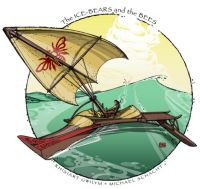
Rhisiart's story ' The Ice-Bears and the Bees ' is a set sometime in the future in a post oil-energy based world. The writer cleverly weaves the story of the coastal sailing community of the future into the story, narrated by an older member of the clan, about a trading voyage to lands where the clan has negotiated treaties for bee hive farms and the trading partners take their share of the harvest to trade for other goods. The tale of a young visionary member of the clan and his revolutionary new craft is woven into the main story. The voyage culminates in the visit to the land of the magical ice bears where the species is being nutured back from extinction under the custodianship of a myserious hermit. The theme of the revitalising of the natural world is symbolised by two events: the birth of a child to the young man's lover in the land of the ice bears and the release of bears back into the lands of the world. A good read.
There were ten entries received for the competition most of a very high standard. Thanks very much to all those that sent in their stories.
The judges for this competition were: Ruth Wharram , Steve Goodman (former JWD Webmaster) and Jennifer Weissel (Author of Running Down Rawana ).

IMAGES
VIDEO
COMMENTS
The Tiki 21 was designed in 1981 as an easy to build Coastal Trek catamaran, using new epoxy/glass stitch & glue techniques. In 1982 the new and then quite radical Tiki 21 was given first prize by Cruising World magazine (USA) in their design competition for a 'Trailable Gunkholer'. Since then nearly 1000 Tiki 21 Plans have been sold (2015).
Tiki 21. A Wharram catamaran. Written by Brad Ingram. From Issue March 2018. J ames Wharram is a multihull pioneer who has been sailing and designing exceptionally seaworthy catamarans since the 1950s. For his first voyage, he built, TANGAROA, a 23' catamaran and sailed her from the U.K. to the Caribbean with Jutta Schulze-Rhonhof and Ruth ...
The tiki 21 should be a quick cheap boat to build but at just 18'6" on the water and 360 kg it's far too fussy. Acorn is the practical boat in that size. It's a beautiful design, weighs nothing, cheap plans, 1 single in each hull with adequate freeboard and headroom. It's a tiny boat but so is the tiki.
This is our modified Tiki 21 full-boat tour. Nômade is a third-hand sailboat made with some modifications and we changed the headroom of the cabins last year...
A short documentary account of a James Wharram designed Tiki 21 catamaran, built from Plan #97 and launched in Canada in 1997, then later transported to Ghan...
Some Tiki sailors have had good luck with ratchet straps and nylon webbing when trailering to daysail. I wouldn't recommend ratchets in lieu of lashings for venturing offshore, however. Scott Williams. The Tiki 21 was designed with cruising accommodations for two, but there is room for more on deck. The catamaran has a carrying capacity of a ...
This is a series of videos on how Kathie and I build a James Wharram and Hanneke Boon designed Tiki 21 catamaran. This is our interpretation of the plans and...
The Tiki 21 was designed in 1981 as an easy to build Coastal Trek catamaran, using new epoxy/glass stitch & glue techniques. In 1982 the new and then quite radical Tiki 21 was given first prize by Cruising World magazine (USA) in their design competition for a 'Trailable Gunkholer'. Since then nearly 1000 Tiki 21 Plans have been sold (2015).
Tiki 21 - Wharram designed catamaran for sale. Slip paid through 10.10.21. Includes Full set building plans. Electric motor. New Sails. Platform between hulls needs replacing. $5,000. OBO. Equipment: Personal Floatation devices, ladder, oars-2, 12 volt battery,2-anchors, mooring lines.
Although small, the Tiki 21 is a proven offshore passagemaker. It was designed as a coastal cruiser by James Wharram in the early 1980s and was never intended for long ocean passages. Despite this, a young man named Rory McDougall built one in Devon, England and left in 1991 bound for New Zealand. He eventually sailed on around the world ...
The Tiki 21 has a 5 hp outboard engine on board and reaches 6.5 knots of speed. The Tiki 26 has a 9.8 hp engine and reaches a speed of 8 knots. Write below in the comments if you have either of these two boats and have different information. I am very interested in how powerful the engine is and how fast the catamaran goes.
Cruising a Tiki 21 on the south coast of Devon, UK, June 2016. Exmouth to Brixham, Noss Mayo (River Yealm), Dartmouth and back. More about this boat at http:...
The TIKI designs range from the coastal trekking/car trailable Tiki 21, to the comfortable and spacious ocean cruiser or charter boat, the Tiki 46. Although a Tiki 21 and a number of Tiki 26s have made ocean crossings, this is only for the experienced sailor. The larger TIKI designs of 30ft and over are craft capable of longer voyages and ocean ...
2,5 hours. Yacht of the Radisson Royal flotilla. Best water route in Moscow. Panoramic views of the capital from the water in winter and in summer. Restaurant with signature cuisine. Next tour: 1800 ₽. Learn more. River tour starting from the Cathedral of Christ the Saviour.
The Voice. The Voice. Legendary karaoke has seen a revival and found its place on famous Tverskaya Street in the very heart of Moscow, in luxurious and mysterious mansion. Cozy atmosphere and. Walk through the Soviet Historical Era of Bishkek of Soviet Kyrgyzstan.
Some images from a good sailing weekend. Tiki 21 catamaran - designed by James Wharram. Florianópolis - Brazil.Help us to create more.https://apoia.se/nomade...
Here you will find many young students aged 18 to 21. People over the age of 30 are a rarity. This means that the vibe is usually pretty cheap and the parties are very loud, with girls dancing at the bar and bartenders putting on a show. ... Tiki was the first man, and in Moscow the Tiki is the first real Hawaiian themed bar. The inspiration ...
Between Tiki 21, which is the smallest catama... Comparison of two Wharram catamarans Tiki 21 vs Tiki 26. What is the difference between two Wharram catamarans.
Maramec Spring Park Mokulua Islands Udo Castillo de Gibralfaro Bravo Farms Cheonjiyeon Falls Tiki Village Cultural Center Rang Reng Cave Cooper Island Champagnes Pommery Scooter rental in San Andres Island Jon Lovitz at the Laugh Factory at the Tropicana Las Vegas Secret Munich - The trail of the Illuminati 9/11 Memorial Audio Tour Experience ...
Rory's Podcasts - Tiki 21 'Cooking Fat' Around The World. Rory McDougall discusses his solo circumnavigation of the world in Tiki 21 'Cooking Fat' in this series of audio podcasts. Tiki 38 'Mon Tiki' Eco Catamaran Project. The Tiki 38 'Mon Tiki' eco catamaran project is a self-sustaining, for profit business serving the summer visitors to Montauk.